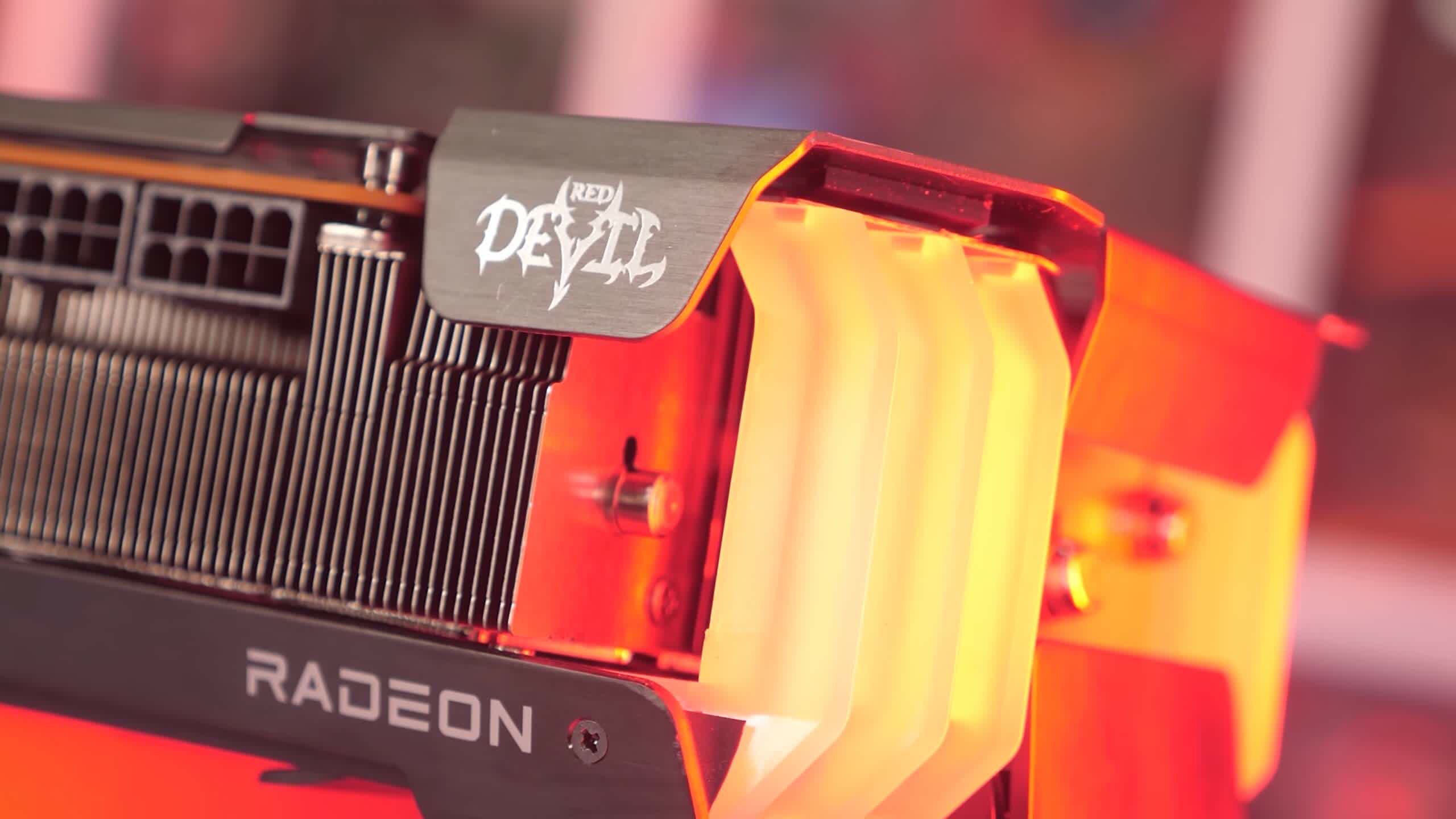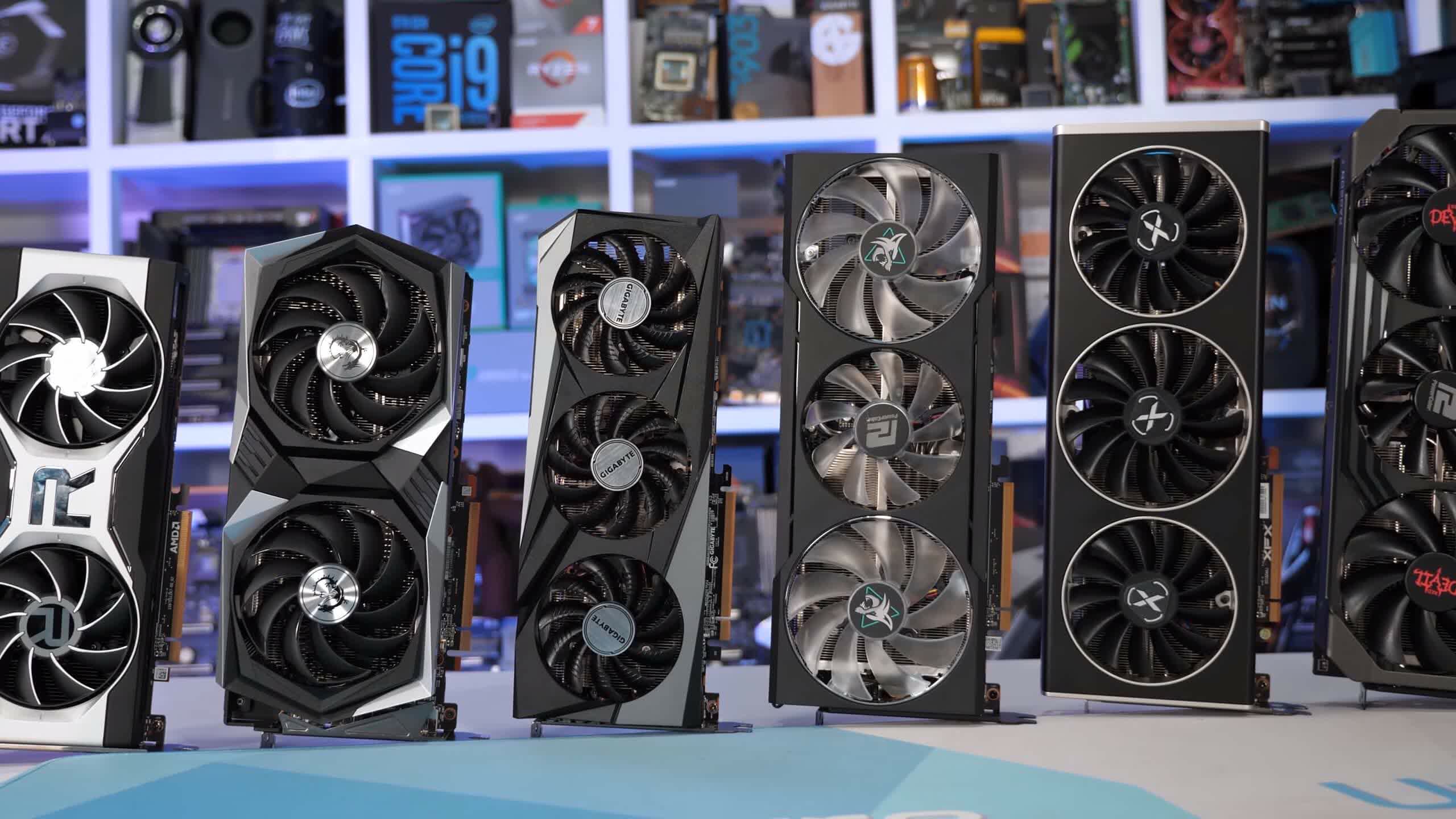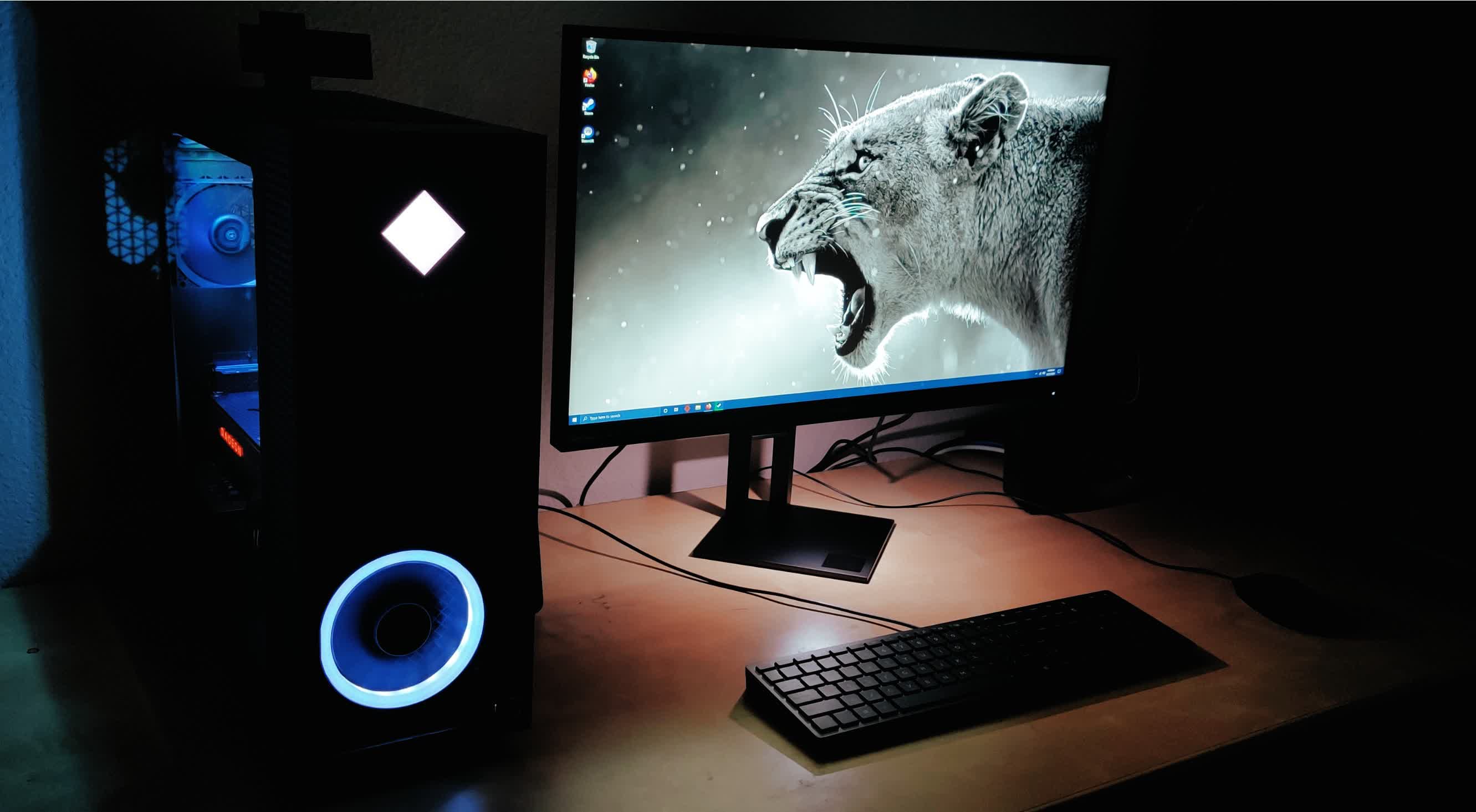Here's our monthly update looking into the current state of the CPU and graphics card markets. The good news is that one of the two is looking quite healthy with a range of easy to buy options for your next build, while the other market is looking perhaps even worse than it was a month ago. This isn't a massive surprise as the global chip shortage continues, but we'll put some numbers to everything a little bit later on.
Updated: See our latest GPU Pricing Update here.
GPU Market Update
The biggest question on everyone's mind is, of course, the graphics card market so we'll start there first. Unfortunately the news is not good: there has been no improvement to the availability nor pricing of graphics cards on a global scale, and in fact things have gotten worse.
Demand remains significantly higher than supply, and despite both Nvidia and AMD pumping out as many GPUs as they can with record sales, it's not enough to satisfy the industry at the moment.
A lot of what we've talked about in the last two market updates is unchanged. That is to say, at most retailers you can't just go in and buy a GPU off the shelf, and if you could buy a GPU, it would be at massively inflated pricing. This includes lower-tier GPUs, everything from GT 1030s right up to RTX 3090s is either out of stock or being sold at crazy prices.

The reasons for this are also unchanged, so we won't go into a full recap of the reasons why the market is like this, if you want more information I'd suggest checking out our previous two updates. But the basics are this: AIB partners are raising the official prices of their custom graphics cards well above the "official" MSRPs set by AMD and Nvidia, in response to market demand, so they can cash in on the gravy train. Distributors are then making the issue worse by either raising prices for graphics cards again, or forcing retailers to buy GPUs as part of bundles with unwanted stock like power supplies or low volume motherboards. There is also an element of these players, both AIBs and distributors, selling large swathes of GPUs directly to miners, reducing the supply for gamers at retail.
The basic situation is that if you're looking for someone to blame, well, direct that anger to the AIBs and board partners who are essentially being a barrier stopping you from purchasing GPUs at the prices Nvidia and AMD have suggested.

What we've heard in discussions with retailers over the last month is that AIBs continue to raise the prices they have set for their graphics cards – these are the MSRPs for board partner models, separate to the Nvidia and AMD MSRPs for the overall GPUs. When an AIB has supply to restock store shelves, often this would be paired with a price increase for the same model, before distributors interfere on top of that. In particular this has affected AMD GPUs like the Radeon 6700 XT, which previously was one of the most reasonably priced GPUs on the market, though still inflated significantly compared to its MSRP.
Also read: Build a PC vs. Pre-Built
(Scoring a GPU in the Process)

One retailer told us this week that GPU prices are now so high from distributors and AIBs that the decision to purchase GPUs when they are available is becoming difficult. That's because the local price for GPUs is far higher than what most customers are willing to spend, so there is significant risk that they won't be able to sell that GPU to recoup costs, a risk that's exacerbated by the possibility of GPU prices going down. If a retailer buys a card for a very inflated price, only to see it not sell, then prices go down, that card will lose the retailer money. This issue appears to be contributing to a lack of readily available GPUs at retailers.
What's notable in this discussion is that pricing for GPUs at retail outside the United States is worse than in the United States when stock is available. Many AIBs set their MSRPs in US dollars and base that decision on the US market, before converting that to local currencies in other territories and applying various taxes, fees and simple regional price increases.
Currently, demand for GPUs in the US is very high and buyers are willing to grab stock even at inflated prices. This causes AIBs to raise their MSRPs, which has a flow on effect of also raising prices in other regions. Except in other regions, pricing is already disproportionately high – usually higher than the direct conversion of USD plus tax for that region – which makes any price increases more likely to push past the point that customers aren't interested any more. This is why you'll often see some cards available in places in Europe and Australia at stupidly high prices, while the equivalent model in the USA is out of stock but at a comparatively lower price.
Also read: What is Cryptomining?
Why is demand for graphics cards continuing to be so high and why are people willing to pay insane prices? The answer is, of course, cryptocurrency mining, specifically Ethereum mining. Last month, we saw a month-on-month increase in Ethereum's price of 24%, which kept GPU pricing on the scalper market relatively flat. This month, it's a different story.

At the time of preparing this article, Ethereum's value had increased 53% compared to the previous month, and that's despite a significant fall off in value over the last week. At its peak about a week ago, Ethereum was over 90% more valuable. Naturally, this is going to increase the profitability of mining relative to last month, increasing demand for GPUs for mining, exacerbating the whole issue.
Here is how Ethereum's price increase has affected the scalper market for GPUs on eBay, with prices captured for completed listings of new products in the last week. It's not good news, with prices for all current generation GPUs increasing month-on-month. Nvidia GPUs were most affected, especially at the high end, with price increases in the 15 to 20% range.
| MSRP | eBay Average Price March | eBay Average Price April | eBay Average Price May | Current Price Inflation | Price Increase March to May | |
|---|---|---|---|---|---|---|
| GeForce RTX 3090 | $1,500 | $3,083 | $3,126 | $3,628 | 142% | 16% |
| GeForce RTX 3080 | $700 | $2,256 | $2,175 | $2,601 | 272% | 20% |
| GeForce RTX 3070 | $500 | $1,374 | $1,400 | $1,660 | 232% | 19% |
| GeForce RTX 3060 Ti | $400 | $1,297 | $1,405 | $1,617 | 304% | 15% |
| GeForce RTX 3060 | $330 | $905 | $884 | $977 | 196% | 11% |
| Radeon RX 6900 XT | $1,000 | $1,870 | $1,814 | $1,972 | 97% | 9% |
| Radeon RX 6800 XT | $650 | $1,560 | $1,480 | $1,690 | 160% | 14% |
| Radeon RX 6800 | $580 | $1,340 | $1,330 | $1,518 | 162% | 14% |
| Radeon RX 6700 XT | $480 | $1,165 | $967 | $1,088 | 127% | 13% |
| Average | 188% | 14% |
Some graphics cards like the RTX 3080 and RTX 3060 Ti are quadrupling their MSRP on average, with both of these models being produced in low volume with dies being used instead for the RTX 3090 and RTX 3070. In particular, the RTX 3060 Ti continues to be virtually non-existent relative to other models.
AMD cards have been spared the most significant price hikes, but still are up on average. The RX 6800 XT and RX 6800 are the most inflated at the moment with an average price 2.6x higher than their MSRPs, while the RX 6900 XT and RX 6700 XT remain the best value choices at only a 2x price increase. "Only" 2x higher than MSRP is as good as it gets right now which is pretty sad. Part of the reason why AMD cards aren't as inflated on the scalper market is they are inferior for mining.
There is a noticeable trend here that the cards with better availability are less price inflated relative to cards around it, and there was considerably more volume of these cards being sold on eBay. I wouldn't advocate buying any GPU at these prices, but the RX 6700 XT might be the best deal on offer if you are desperate.

Another interesting thing to note is that for several months now, the price of GPUs on the scalper market is not directly pegged to the price of Ethereum. GPU pricing does follow the general trend of cryptocurrencies, but not at a 1:1 ratio. For example this month, on average GPU prices increased by 14%, however Ethereum was up by a whopping 53%. So for GPU prices to rise, Ethereum needs to increase significantly more.
Why is this the case? Mining isn't a simple situation where you plug in a GPU and it makes coins at a steady rate forever. The profitability of mining is related to the price of the currency you're mining, but it's also affected (in Ethereum's case) by two other factors: difficulty and gas prices.
As more people mine Ethereum, the algorithm adjusts the difficulty of mining in an attempt to keep the rate of currency production flat. This gives each miner a proportionally smaller block reward from mining over time, reducing profitability. Over the last month, Ethereum mining difficulty has risen 10 to 20 percent depending on the source you look at, which has eaten into the gains from the currency itself.

The other factor is gas prices, or the price to complete a transaction on the Ethereum network. When gas prices are high, miners charge more for processing transactions, and therefore earn more as a reward for doing so. Along with block rewards, this is how miners make money. Gas prices fluctuate a lot and it isn't a steady increase over time like with difficulty, but over the last week the price has been declining, which again eats into the profitability of mining.
So how does the GPU market improve from here? I mean, we've just seen even worse prices than last month, so how on earth does it get better?
The most obvious way is if mining profitability goes down, making GPUs less attractive for miners at high prices. This can occur in several ways: the price of Ethereum goes down, difficulty goes up, or gas prices go down. Any one of these things, or ideally a combination, reduces profitability. You can be pretty sure that difficulty will continue to increase, so it's just a matter of Ethereum's price not significantly outpacing this rise. We saw this cycle happen before in the last crypto boom, and it will happen again.
Beyond that, there are other factors that will come into play in the next few months...
One is Nvidia's reintroduction of LHR or "Lite Hash Rate" GPUs, which will reimplement a cryptocurrency mining limiter for the RTX 3060 and other GPUs. These graphics cards feature a small revision that requires a new driver to run, a driver that will have the hash rate limiter enabled, with the inability to use the GPU with older drivers that don't feature this limiter.

How successful this will be is up in the air. Last time Nvidia tried this with the RTX 3060, they botched their own efforts accidentally by removing the limiter through a driver update. It also remains to be seen how easy the limiter is to bypass. In a recent poll we ran, around 60% of the 83,000 people that responded were in favor of Nvidia limiting mining performance on GeForce GPUs.
Both Nvidia and AMD are also set to release new GPUs in the next few months, with rumors circulating around the GeForce RTX 3080 Ti and RTX 3070 Ti, along with AMD's Radeon RX 6600 series. Whether or not these graphics cards will improve supply significantly is unknown, but there is a chance, especially with a smaller die likely being used for the 6600, meaning more GPU dies per 7nm wafer.
Then further down the track, the Ethereum network is set to introduce changes that most in the community expect will reduce the profitability of mining. One is EIP 1559 that is set to reduce gas fees in July. We're not going to go into detail about this, but you can look it up if you want to dive deeper into how Ethereum works and their roadmap.
So if we had to summarize the GPU market right now, it's absolutely horrible and the worst it's ever been, but there are various developments underway that should bring improvements soon enough.
CPU Market Update
In much more positive news, the CPU market is almost back to normal operation. Particularly if you want to buy an Intel CPU there is no shortage of options on the market, with pretty much everything available from the 10th and 11th generations. AMD CPUs are also becoming more available depending on your region.

First up we have Intel processors, and the good news is that 10th-gen parts are still readily available. This is excellent because we still feel that Intel's prior generation line offers great value at the moment, given that they are typically being sold for lower prices than their 11th-gen counterparts.
Also read: Top 5 Best CPUs
For example, take the Core i7-10700KF which remains at $300, the same price as the Ryzen 5 5600 despite having 8 cores instead of 6, and a full $100 lower than the Core i7-11700K that just launched.
Similar situation with the Core i5 range. You can buy the Core i5-10400 for $170, or the Core i5-11400 for $210. The locked Core i5-F models are a little harder to find than a month ago, but overall there's still a great selection of Intel processors available for very competitive prices.

It's not totally clear how much longer 10th-gen parts will stick around given Intel's focus on producing their newer 11th generation. However judging by Amazon's best selling CPUs list, current supply of 10th-gen parts is likely existing stock given that even with decent product, Intel isn't capturing the interest of buyers right now. The most popular CPU from Intel on Amazon is the Core i5-10600K, sitting in 7th position behind even the Ryzen 5 1600.
As for AMD CPUs, in most regions around the world you can buy any of AMD's Ryzen 5000 processors right now. They are readily in stock at the MSRP, including the Ryzen 9 5900X which has been difficult to find since launch. So in general, it's taken AMD about six months to produce sufficient supply of Zen 3 CPUs to meet market demand.
The one exception appears to be the United States. While the Ryzen 5 5600X is in stock, and the 5800X is even sold at a small discount, Ryzen 9 parts are still difficult to come by. Given stock levels in other countries look good and supply there is meeting demand, it shouldn't be too long until the same situation is seen in the States as well.

We still aren't back to a position where last-gen AMD processors are sold at a discount. Parts like the Ryzen 5 3600 and Ryzen 7 2700X remain at their launch MSRPs which isn't a very attractive proposition in the current market, especially compared to what Intel are offering.
But AMD seems to be set on current CPU pricing for a reason: they've built up a strong AM4 platform which provides a lot of upgrade paths for people without needing a motherboard upgrade. For many, replacing first gen Ryzen with a Ryzen 5 3600 at $200 is still better than buying a new motherboard with an Intel upgrade path. Without cheaper Zen 3 processors, there's little incentive to reduce last-gen prices. AMD are also capitalizing on lukewarm reception for Intel's 11th-gen processors so far, with AMD being in the rare position of being perceived as the "better" CPU brand.
